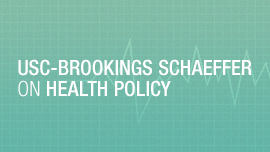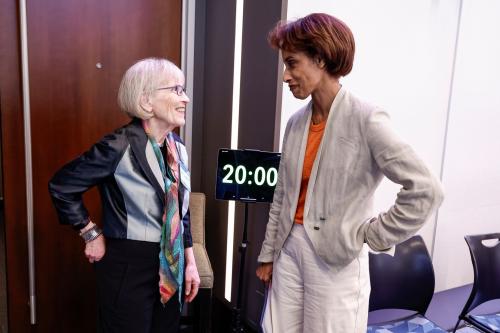This blog post is part of the USC-Brookings Schaeffer Initiative for Health Policy, which is a partnership between Economic Studies at Brookings and the University of Southern California Schaeffer Center for Health Policy & Economics. The Initiative aims to inform the national health care debate with rigorous, evidence-based analysis leading to practical recommendations using the collaborative strengths of USC and Brookings.
Generic drugs are essential for bringing price competition to prescription drug markets and providing a moderating force on drug spending. They make up 92% of prescriptions, but only 16% of invoice-level spending in the US.
This price competition relies on a determination by FDA that generic products are therapeutically equivalent to a brand name drug. That determination enables the generic drug to be automatically substituted at the pharmacy counter for the brand-name product. This in turn allows lower priced generics to quickly take market share from the more expensive brand. Therapeutic equivalence rating also unlocks competition for physician-administered drugs: drugs rated as such are combined into a single Medicare reimbursement code with the branded version, which drives down reimbursement of the brand and, with it, shifts utilization to the less expensive generics.
Despite the competitive importance of therapeutic equivalence, FDA does not assign therapeutic equivalence (TE) codes at approval to all eligible drugs, thereby leaving “money on the table” and disadvantaging American consumers.
In this blog, we explain FDA regulations and practices for assigning TE codes, describe how the current FDA process to assigning TE codes fails for many sterile injectable drugs, and propose ways in which either FDA or Congress could address the existing delays in TE assessments. In our view, current legislative proposals that would set a 180-day deadline for FDA review of Citizen Petitions requesting TE codes represent an important improvement in promoting competition in the prescription drug market. However, FDA should go further by incorporating TE determinations at approval.
FDA regulations and practices governing therapeutic equivalence determination
Therapeutically equivalent generic products have the same active drug ingredient as the reference brand name drug, in the same amount, dosage form and route of administration. They are also bioequivalent to the branded product, meaning there is no significant difference in rate and extent of the active ingredient in the body after administration. But therapeutic equivalence allows for differences in characteristics such as inactive ingredients, shape, packaging, and expiration date.
If FDA determines a drug product to be therapeutically equivalent to other pharmaceutically equivalent products, the Agency will assign the drug a so-called A rating. Generally, solid oral dosage forms (e.g., tablets and capsules) will receive an AB rating. Drug formulations with no known or suspected bioequivalence problems are designated as AA, AM, AO, AP, or AT, depending on the dosage form. For example, AP is reserved for parenteral (injectable) drugs and AO for injectable oil solutions. The TE code is almost always assigned at approval if the drug is approved under the Abbreviated New Drug Application (ANDA) pathway, which is the standard approval pathway for generics.
While therapeutic equivalence allows for differences in inactive ingredients, FDA requires injectable drugs to contain, with some exceptions, the same inactive ingredients (Q1) in the same concentration (Q2) as the reference listed drug (branded product) if they want to obtain market authorization using the ANDA pathway. This is known as the ANDA Q1/Q2 sameness requirement.
The Q1/Q2 sameness requirement can create barriers to entry if inactive ingredients are part of the branded product’s patenting strategy. If a generic manufacturer wants to get around patents involving product formulation listing inactive ingredients, they must sidestep the ANDA pathway. In those situations, the FDA directs them to what is called the 505(b)(2) pathway to approval, with review done by the Office of New Drugs, rather than Office of Generic Drugs. This move will put the applicant in the domain of the Prescription Drug User Fee Agreement (PDUFA), which comes with higher user fees but better turnaround times than the Generic Drug User Fee Agreement (GDUFA). Obtaining a TE rating will remove the drug from the obligation to pay ongoing PDUFA product user fees.
But unlike with ANDAs, FDA does not automatically assign TE codes to eligible applicants who use the 505(b)(2) pathway. Instead, the FDA asks generic companies to file Citizen Petitions post approval.
FDA performance with reviewing 505(b)(2) therapeutic equivalence determination requests
To assess how the 505(b)(2) pathway is currently functioning for these drugs, we undertook a review of Citizen Petitions seeking an A-rating. We identified 22 such Citizen Petitions. As can be seen here, these petitions represent 28 drugs, all of them injectables. Of those, 25 are seeking an AP rating, two an AB rating and one an AO rating. Of the 28, 20 are only approved for intravenous route of administration, which should automatically qualify them for a biowaiver and for what should be an automatic AP rating if otherwise the drug is pharmaceutically equivalent. The remaining eight drugs have either a different or an additional parenteral route of administration: subcutaneous or intramuscular injection. These routes may require additional data to substantiate they are eligible for an A rating.
FDA has been very slow to take action on these 505(b)(2) Citizen Petitions, as illustrated in the figure below. Of the A-rating requests 22 petitioners submitted, the only petition granted by FDA was for Xellia’s voriconazole for injection. That petition took 654 days to resolve. FDA denied one petition because the reference brand drug was discontinued. Four were withdrawn by petitioners, including one where the petitioner discontinued marketing the drug. The others are still in queue, with most having already waited two or three years.

FDA’s long delays in handling Citizen Petitions have failed to promote competition, keeping costs higher for consumers and purchasers. The cost of these delays is underscored by a recently announced change to the way Medicare pays for these products. In November 2022, the Centers for Medicare and Medicaid Services (CMS) announced in guidance its intention to issue separate reimbursement codes for the kinds of unrated generic 505(b)(2)s drugs that we describe in this blog. CMS had been including those drugs in the same reimbursement (HCPCS) code as the branded product, which meant lower reimbursement for the brand and therefore an incentive to providers to switch to higher provider margin 505(b)(2) alternatives.
The CMS guidance—which now legally aligns the multisource drug determination with FDA’s TE determination—means that the benefits of competition are lost unless these companies obtain A-ratings, thus increasing the importance of FDA process to assign TE ratings to these products.
Policy solutions to expediting review of 505(b)(2) therapeutic equivalence determination requests
In responding to petitioners, FDA has indicated that addressing these 505(b)(2) TE petitions falls behind other Agency priorities. One follow-up letter from September 2020 stated that “FDA has been unable to reach a decision on your petition due to the need to address other Agency priorities. (…) We will respond to your petition as soon as possible given the numerous demands on the Agency’s resources.” The petition is still pending.
In this section, we discuss three ways to accelerate consideration of these TE petitions: user fee process improvements, a Congressional mandate, and greater executive branch engagement.
User fee process improvement
Typically, review process inefficiencies and resource constraints are resolved through user fees. FDA and industry identify inefficient processes and then agree on proposed process changes, funding, and performance commitments.
Generic drug applicants are not at the negotiating table for the branded drug program that funds their 505(b)(2) review. Additionally, industry participants in the negotiations lack incentives to support quick TE ratings for competitor products that will erode their sales.
Unfortunately, TE rating requests by 505(b)(2) applicants sit in a gray area that falls in between the two main user fee domains. Section 505(b)(2) TE applicants are really generic companies, which typically use processes that fall in the GDUFA domain. However, the 505(b)(2) pathway is funded by PDUFA for which TE petitioners are typically not at the negotiating table. Any additional TE review work in the 505(b)(2) process, however minimal, could jeopardize FDA’s performance on PDUFA timelines, compromising commitments that FDA has made to the stakeholders that are at the table in that process. For these reasons, we do not see changes to PDUFA as a likely remedy for this problem.
Although implementing a by-request TE rating review into PDUFA may be unrealistic, creating a new user fee under GDUFA may be an option. Such fees would provide funding and performance goals for FDA. However, it would be challenging, but not impossible, to align a GDUFA TE review with the PDUFA 505(b)(2) review. Additionally, this policy direction would necessarily be a long-term solution because the next iteration of user fees will not be in place until 2027.
Congressional mandate
As we indicated above, the problem at hand is a resource and priority issue, not a lack-of-mandate issue. In the current user fee climate, the Citizen Petition process is FDA’s preferred pathway, but Congress can mandate FDA to expedite processing these reviews. A bill establishing 180-day review timelines for Citizen Petitions is currently included in the riders that Congress may pass in with the year-end package.
Giving FDA a timeline would be a step in the right direction. We would also recommend additional appropriations to address resource constraints. Those appropriations would likely be modest given the relatively low volume and simplicity of these TE requests—recall that the overwhelming share of these drugs are intravenous only and therefore should qualify for so-called biowaivers, which make the bioequivalence aspect of the TE code determination automatic. However, even with funding and a Congressional mandate, we worry priorities may still remain elsewhere.
Executive branch engagement
Even if a 180-day Citizen Petition review timeline is enacted into law, post-approval TE code determinations via Citizen Petitions represent an unnecessary delay for the small number of 505(b)(2)s that might request it upon approval. Such delays are inconsistent with the spirit of President Biden’s July 2021 Executive Order on Competition, which encouraged policy measures to address drug pricing.
The White House can encourage FDA to improve its approach to TE ratings by integrating the assignment of TE ratings into approval process of future 505(b)(2)s instead of requiring post-approval Citizen Petitions. For dealing with the backlog of Citizen Petitions and for incorporating by-request determinations into the approval process, FDA could seek additional funds through the President’s Budget—a move that should be embraced by the Administration given the budget request’s alignment with President Biden’s executive order.
The Brookings Institution is financed through the support of a diverse array of foundations, corporations, governments, individuals, as well as an endowment. A list of donors can be found in our annual reports published online here. The findings, interpretations, and conclusions in this report are solely those of its author(s) and are not influenced by any donation.
-
Acknowledgements and disclosures
We would like to thank Rachel Turow for sharing the list of 505(b)(2)s seeking TE codes, Amalis Cordova-Mustafa for helping to compile data presented in the attached table, and Conrad Milhaupt for his support with data visualization. We would also like to thank Matt Fiedler, Marty Shimer, and Rachel Turow for providing excellent comments on an earlier draft of this blog.
The Brookings Institution is committed to quality, independence, and impact.
We are supported by a diverse array of funders. In line with our values and policies, each Brookings publication represents the sole views of its author(s).






Commentary
Some drugs that improve price competition fall through the cracks of FDA user fees
December 12, 2022